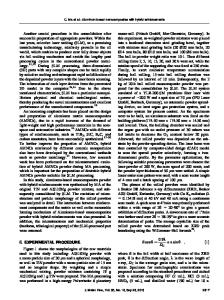New Fe-Ni Based Metal-Metalloid Glassy Alloys Prepared by Mechanical Alloying and Rapid Solidification
- PDF / 362,979 Bytes
- 6 Pages / 414.72 x 648 pts Page_size
- 51 Downloads / 359 Views
ABSTRACT Mechanical alloying and rapid solidification are two important routes to obtain glassy alloys. New Fe-Ni based metal-metalloid (P-Si) alloys prepared by these two different processing routes were studied by differential scanning calorimetry and transmission Mbssbauer spectroscopy. Mechanical alloyed samples were prepared with elemental precursors, and different nominal compositions. Rapidly solidified alloys were obtained by melt-spinning. The structural analyses show that, independent of the composition, the materials obtained by mechanical alloying are not completely disordered whereas fully amorphous alloys were obtained by rapid solidification. Consequently, the thermal stability of mechanically alloyed samples is lower than that of the analogous material prepared by rapid solidification. The P/Si ratio controls the magnetic interaction of the glassy ribbons obtained by rapid solidification. The experimental results are discussed in terms of the degree of amorphization and crystallization versus processing route and P/Si ratio content. INTRODUCTION Fe-based alloys prepared by rapid solidification (RS) have excellent magnetic properties. These alloys were widely investigated during the last two decades [1]. Nevertheless, they did not attain an important level of applicability in the industrial processes, as could be expected from their good magnetic properties. The possible cause is that these materials were usually obtained only by RS in ribbon form and this limits its technological use. In recent years, the mechanical alloying technique (MA) was introduced to produce Fe-Based amorphous alloys [2-3]. Using MA at ambient temperature amorphous powders have been obtained in great quantity and a very large composition range. This work deals with analysis and comparison of powders obtained by MA in a planetary mill and by melt spinning under controlled atmosphere. EXPERIMENTAL The powdered materials were synthesized by milling mixtures of elemental powders (particle size up to 25 ýtm) in containers closed under an Ar atmosphere. Elemental Fe, Ni, P and Si were used to prepare alloy powders with the following nominal compositions: Fe 4 oNi 40P2 0_xSix with x = 6, 10 or 14. These samples were labeled as MA(A), MA(B) and MA(C), respectively. The 489 Mat. Res. Soc. Symp. Proc. Vol. 455 © 1997 Materials Research Society
powders were milled in a Frisch Pulverisette 7 planetary ball mill, using hardened steel containers and balls. The ball-to-powder weight ratio was 5:1 and the milling intensity was held at an intensity setting of 7. The melt-spun ribbons were produced by quenching the molten alloy on the surface of a rapidly spinning (about 30 ms-1) Cu wheel, under an Ar atmosphere. To prevent P sublimation, the Fe 3 P compound was used along with elemental Fe, Ni and Si to prepare ribbons with the same nominal compositions as the powders. These samples were labeled as RS(A), RS(B) and RS(C) when x = 6, 10 or 14, respectively. Differential scanning calorimetry (DSC) was carried out in a DSC-7 Perkin-Elmer calor
Data Loading...











